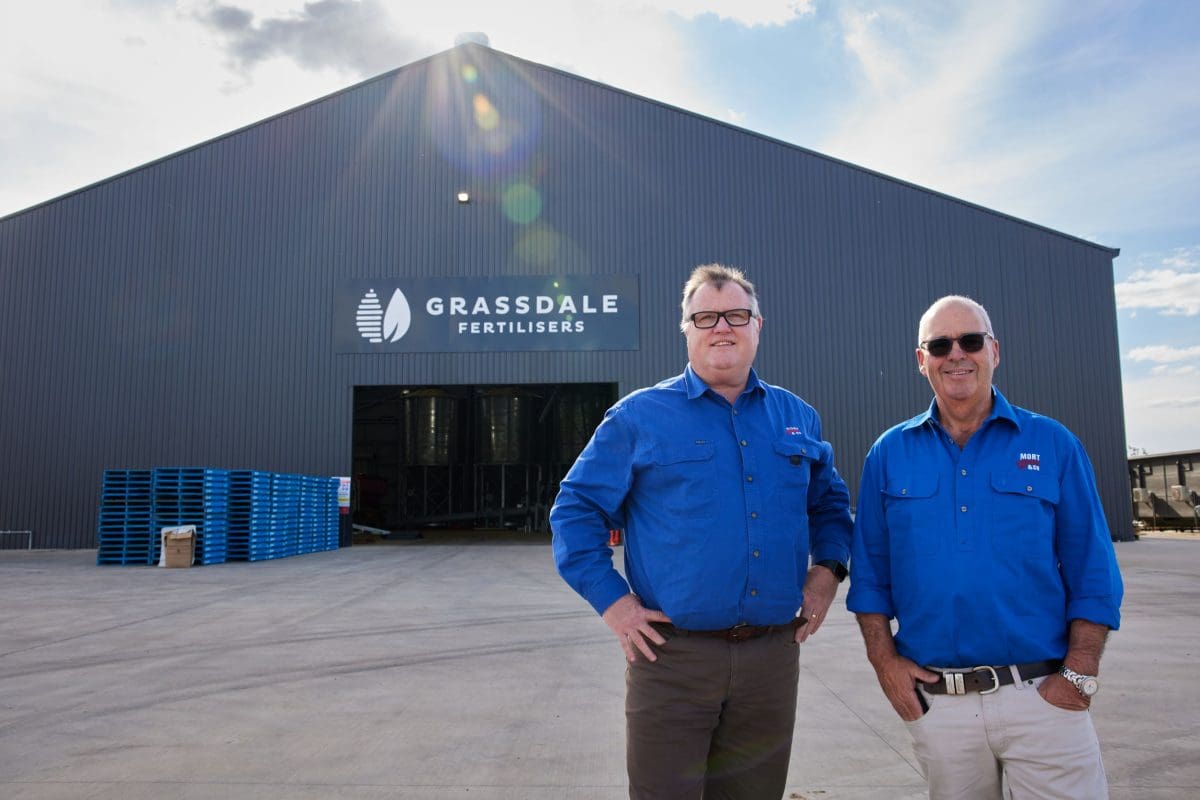
Mort & Co CEO and Grassdale Fertiliers chairman Stephen O’Brien and Mort & Co executive chairman Charlie Mort at the Grassdale Fertilisers factory north of Cecil Plains on Queensland’s Darling Downs. Photo: Grassdale Fertilisers
A GRANULAR fertiliser plant at Australia’s largest feedlot, Grassdale, is being commissioned with an annual production capacity of 20,000 tonnes and plans to increase it to 100,000t by early 2023.
The move is believed to be a first for an Australian feedlot, and the joint venture will add value to composted manure produced at the 77,000-head facility.
While it will reduce the reliance of Grassdale’s cropping operation on inorganic fertilisers, its output will primarily be sold to domestic and potentially export customers.
“There has been a lot of interest from growers from the Darling Downs down into central New South Wales,” Grassdale Fertilisers manager Brad Smith said.
“Even in areas where bulk cheap cow manure is available, growers are seeing the benefit of a smaller targeted application of granules, say 100-200 kilograms per hectare, instead of 10t/ha, which is a huge logistical effort to transport and spread.”
Mr Smith said there was already strong interest from customers in Southeast Asia, Vietnam in particular, and customers in South Australia and Western Australia were also keen.
“SA is easier to access by road but it looks like sea freight to WA will be the better option.”
Carbon value
The Grassdale farm conducted a trial last year of the home-made granules, and Mr Smith said the farm manager saw an important role for the carbon-based granules as a component of his fertiliser program.
Mr Smith said increased awareness around soil carbon, soil health and sustainability was driving much of the interest in Grassdale granules.
“Terrus granules are 31pc organic carbon, which equates to 1.1t of CO2 equivalent, and with the current price of a carbon credit at $50 and predicted to go as high as $180 within the year, this represents real value.”
A carbon life-cycle assessment of the feedlot and Grassdale Fertilisers’ three formulations is currently under way, and will quantify the carbon benefit.
“Chemical fertilisers make up the majority of a farm’s carbon footprint.
“Replacing some of that chemical fertiliser with Grassdale granules will help to reduce their carbon footprint.”
Granules allow accuracy
Mr Smith said the Grassdale Fertilisers granules allow farmers to accurately apply compost into the soil in a form that can with existing fertiliser equipment, including airseeders.
“The granules are the same shape, size and weight and crush strength as urea.”
Granules are dried to 10-per-cent moisture, which makes them hard, free flowing and stable.
“The organic fertiliser industry has had a problem with excessive moisture and soft pellets in the past, so the selection of the type and size of the dryers was critical to ensure the quality of the granules.”
Additional inputs going into granules include blood and bone, which will be sourced from the nearby Oakey Beef Exports plant, gypsum, and sulphate of potash.
The high-purity gypsum is being sourced from within Australia, and fine milled locally to -40 micron.
“This fine grade is much more available to the plants, meaning less is required.”
Sulphate of potash is permissible as an organic input, and the imported product is available to Grassdale Fertilisers through two Australian fertiliser distributors.
“We can purchase from either.”
Mort & Co is coordinating all of Grassdale Fertiliser’s marketing, and a price indication for product is yet to be issued.
